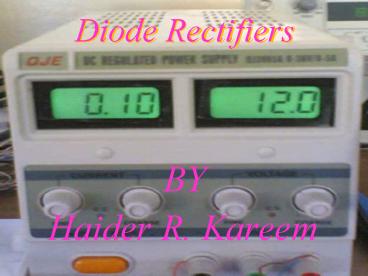Diode Rectifiers - PowerPoint PPT Presentation
1 / 11
Title:
Diode Rectifiers
Description:
BY Haider R. Kareem Diode Rectifiers Diode Rectifiers This presentation describes the application of diode rectifier circuits. It covers single-phase rectifier circuits. – PowerPoint PPT presentation
Number of Views:1156
Avg rating:3.0/5.0
Title: Diode Rectifiers
1
Diode Rectifiers
- BY
- Haider R. Kareem
2
Diode Rectifiers
- This presentation describes the application of
diode rectifier circuits. It covers single-phase
rectifier circuits. The objectives of this
presentation are - To enable the readers to understand the operation
of typical rectifier circuits. - To enable the readers to appreciate the different
qualities of rectifiers required for different
applications.
3
Single-phase Diode Rectifiers
- There are two types of single-phase diode
rectifier that convert a single-phase ac supply
into a dc voltage, namely, single phase half-wave
rectifiers and single-phase full-wave rectifiers.
In the following subsections, the operations of
these rectifier circuits are examined and their
performances are analyzed and compared .
4
Single-phase Half-wave Rectifiers
- The simplest single-phase diode rectifier is
the single-phase half-wave rectifier. A
single-phase half-wave rectifier with resistive
load is shown in Fig.(1). The circuit consists of
only one diode that is usually fed with a
secondary transformer as shown in Fig(1). During
the positive half-cycle of the transformer
secondary voltage, diode D conducts. During the
negative half-cycle, diode D stops conducting.
the voltage and current waveforms of resistive
load R and the voltage waveform of diode D are
shown in Fig. (2).
Fig (1)
Fig(2)
5
Single-phase Full-wave Rectifiers
- There are two types of single-phase full-wave
rectifier, namely,full-wave rectifiers with
center-tapped transformer and bridge rectifiers.
A full-wave rectifier with a center-tapped
transformer is shown in Fig. (3). It is clear
that each diode, together with the associated
half of the transformer, acts as a half-wave
rectifier. The outputs of the two half-wave
rectifiers are combined to produce full-wave
rectification in the load. The voltage and
current waveforms of the full-wave rectifier are
shown in Fig. (4). By observing diode voltage
waveforms vD1 and vD2 in Fig. (4), it is clear
that the PIV of the diodes is equal to 2Vm during
their blocking state.
Fig (3)
Fig (4)
6
Single-phase Full-wave Rectifiers
- A bridge rectifier as shown in Fig. (5) can
provide full-wave rectification without using a
center-tapped transformer. During the positive
half cycle of the transformer secondary voltage,
the current flows to the load through diodes D1
and D2. During the negative halfcycle, D3 and D4
conduct. The voltage and current waveforms of the
bridge rectifier are shown in Fig. (6).
Fig(5)
Fig(6)
7
Performance Parameters
- The performance of the rectifiers mentioned
above will be evaluated in terms of the following
parameters - The average value of the load voltage VL is Vdc
and it is defined as
8
Performance Parameters
- The root-mean-square (rms) value of load voltage
vL is VL, which is defined as
9
Performance Parameters
- The Form Factor (FF) is defined as the ratio of
the root-mean-square value of a voltage or
current to its average value.
10
Performance Parameters
- The ripple factor (RF), which is a measure of the
ripple content, is defined as
11
THANK YOU































